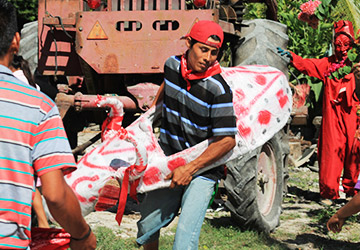Reflections on Ethnicity and Nation in Belize

Reflections on Ethnicity and Nation in Belize
Culture, History
Reflections on Ethnicity and Nation in Belize
by Assad Shoman (PhD)
Belize, a Central American state with “Caribbean” connections, has been known for its small but ethnically diverse population. I put that word in quotes because for Belize it has carried a special meaning, the Caribbean that includes the territories that were colonies of Britain, and that feature populations predominantly of African descent. And indeed, even for people in the other Central American states, to say that Belize is Caribbean has meant that it is peopled predominantly by Afro-descendants. The territory that is now Belize was once, before the period of European invasion, an undifferentiated part of a large area inhabited by indigenous peoples collectively called Maya but including peoples of different languages and traditions, encompassing parts of what are now Mexico, Guatemala and Honduras, as well as Belize.
The Spanish were the first Europeans to enter Belize; they were resisted by the indigenous peoples, but succeeded in establishing several villages and attempted to impose their Catholic religion. The Maya resistance to Spanish rule continued from the first contacts in 1508 until the end of the seventeenth century, but by then Spain began to lose control of the territory to British pirates, and eventually British settlers controlled the territory and imported Africans as slaves to cut and export wood from the settlement; in 1779 slaves accounted for 86% of the population within British jurisdiction. The reduced Maya population was not counted.
Early in the 19th century, the Garifuna1 (known to the British as Black Caribs, they were a people of African and indigenous Caribbean origin who had been forcibly removed from their island home of St. Vincent by the British and transported to an island off Honduras in 1797) began to settle in the south of Belize. After slavery was abolished in 1838, the British cutters were deprived of some of their labour, but the population was doubled by refugees from the Caste War in Yucatan in the years after 1847, as Mayas and Mestizos peopled northern Belize. In the 1860s, the labour-hungry British imported indentured servants from India and China. People were also brought by the British from their other colonies in the Caribbean. This mix of peoples was enriched in the twentieth century by immigrants from several parts of the world, including peoples from the Middle and Far East, the Caribbean, Europe and Central America. For a country with such a small population (in 1945 less than 60, 000; in 1981 146,000; in 2009 about 330,000), the great ethnic diversity in Belize is striking. Equally striking is the impression carried by many, including locals as well as visitors, that Belize is a haven of ethnic harmony.
But Belize was made by slavery and imperialism, both institutions that thrive on racism, and it would be foolish to believe that Belizean society has not been marked by its racist foundations.
In this essay I want to share some reflections, as a person born and bred in Belize, that is to say as a witness and participant from the inside, about ethnic relations, racism, and nation-ness in Belize. I believe that to do this it is important to address the colonial experience of Belize, for people‘s thoughts and feelings about ‗race‘, ethnicity, colour, difference, and identity were forged in the crucible of their lived experience of slavery and colonialism. I also want to explore the question of nationalism, of what it meant and means to be Belizeans ―building a nation‖, as we have been called upon to do by leaders for more than a half-century, and to reflect on the relation between nation and ethnicity.
Part 1 presents essential background and addresses the issue of British colonialism and its racist essence, describes the emergence of a ―Creole culture‖ in the colony, explains the effect of nationalist politics on ethnic relations, relates the reactions of different sectors and groups in the society to the pattern of ethnic relations, and introduces the phenomenon of Central American immigration in the 1980s and its effects on the concerns about preserving an ―ethnic balance‖. In Part 2 I will present different views about ethnicity and ethnic relations in Belize, analyse the concepts of “race,” ethnicity and nation by reference to the current academic literature, look critically at some conceptualizations about the meaning of ethnicity and the state of ethnic relations in Belize, present the special case of the Toledo Maya, and provide some reflections about how the issue might be better understood and addressed.
Read full article here!
How to Cite:
Shoman, A. (2010). Reflections on Ethnicity and Nation in Belize. Documento de Trabajo No. 9. from https://hal.archives-ouvertes.fr/hal-00713503/file/Cuaderno9-SHOMAN-FINAL-2.pdf
